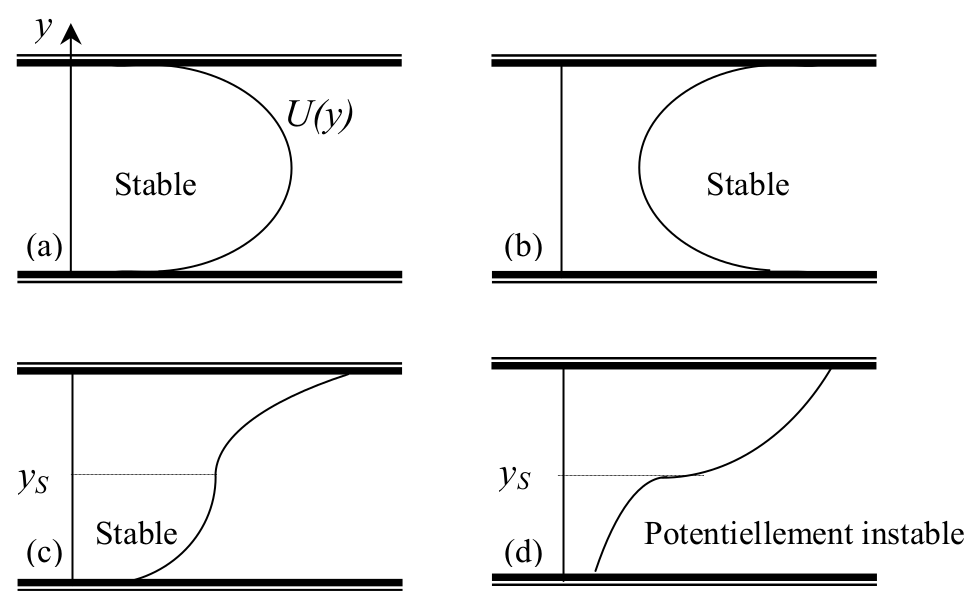Fluid instability mechanisms and conditions#
Squire’s theorem#
Squire’s theorem states that for flows governed by the incompressible Navier-Stokes equations, the perturbations of a two-dimensional flow which are least stable are also two-dimensional.
One-dimensional shear \(U(z)\), inflection point theorem#
Rayleigh’s equation (inviscid Orr-Sommerfeld equation).
Derivation#
We start from the inviscid Navier-Stokes equation
Two-dimensional perturbation around a shear: \({\boldsymbol{v}}= (U(z) + u, 0, w)\).
We eliminate the pressure:
This is actually the equation for the \(y\) component of the vorticity \(\omega = {\partial}_x w - {\partial}_z u\).
The flow is incompressible and 2d so we can use a streamfunction \(\psi\) such as \(u = {\partial}_z \psi\) and \(w = -{\partial}_x\psi\). The vorticity is equal to \(\omega = - ({\partial}_{xx} + {\partial}_{zz}) \psi\), which gives:
Let’s use the symmetries of the problem with time and \(x\) so every function can be written using the Fourier transform:
with \(k\) a real wavenumber and \(c\) a complex speed. We can replace the operators \({\partial}_t\) and \({\partial}_x\) by \(-ikc\) and \(ik\), respectively and we obtain the Rayleigh equation (1).
Theorems#
Integration by part + limit conditions:
The right hand side term can also be written as
so we obtain two conditions
and
We first conclude from the first quantity that such shear can be linearly unstable only if \(U''(z_i)\) changes sign (i.e. if the profile has an inflection point).
One can infer from the two conditions a more restrictive version that states that a velocity profile that has an inflection point \(z_i\) can be linearly unstable only if \(U''(y) (U(y) - U(y_i)) < 0\).

Fig. 8 Stability for different velocity profiles. There is no inflection point in
(a) and (b) so these profiles are stable. (c) has a inflection point but
is stable since \(U''(y) (U(y) - U(y_i)) > 0\). (d) could be unstable.#
Note
Flow in a tube, Reynolds experiment and sub-critical instability…
Centrifugal instability (Rayleigh criterion)#
Flows with curved streamlines, such as those sketched in Fig. 9, can be unstable due to the centrifugal force. There is a simple inviscid criterion for the instability of a basic swirling flow with an arbitrary dependence of angular velocity \(\Omega(r)\) on the distance \(r\) from the axis of rotation (\(u_\theta = r\Omega\)). The centrifugal instability can develop if

Fig. 9 Examples of swirling flows.#
This criterion can be explained by considering the Euler equations for a bidimensional (\(w=0\) and \({\partial}_z = 0\)) incompressible flow expressed in cylindrical coordinates:
where the material derivative is
The continuity equation is
The equation for the vorticity is:
Show that this leads to a simple equation for the vertical component of the vorticity \({\text{D}_t}\omega_z\).
Exercise 3
How should we obtain these equations?
Energetic argument#
Using (3) and (4), it can be shown that the angular momentum \(H = r u_\theta\) is conserved along the trajectory of a fluid particle \( {\text{D}_t}(r u_\theta) = 0\).
The kinetic energy per mass unit is equal to \((H/r)^2/2\). We consider two fluid particles with equal volume. The sum of their kinetic energy is
Let’s consider the swaps of the positions of the 2 particles. The new kinetic energy is
The difference can be written as
If the swap has released energy (\(\Delta E < 0\), \({H_1}^2 > {H_2}^2\)), the laminar base flow will be unstable to such swaps. Thus the criterion is
Recalling that \(H = r^2 \Omega\), the condition for instability as a function of \(r\) and \(\Omega\) is
which is consistent with the Rayleigh criterion (2).
